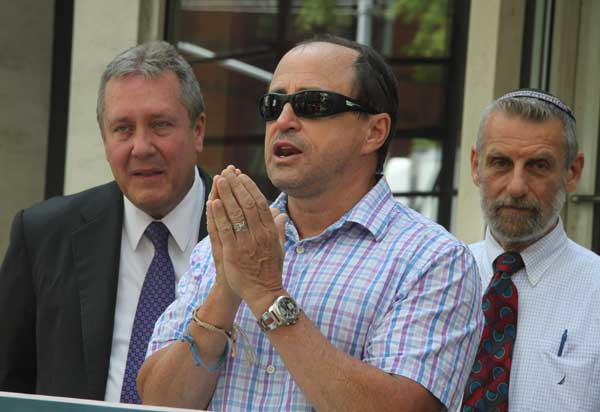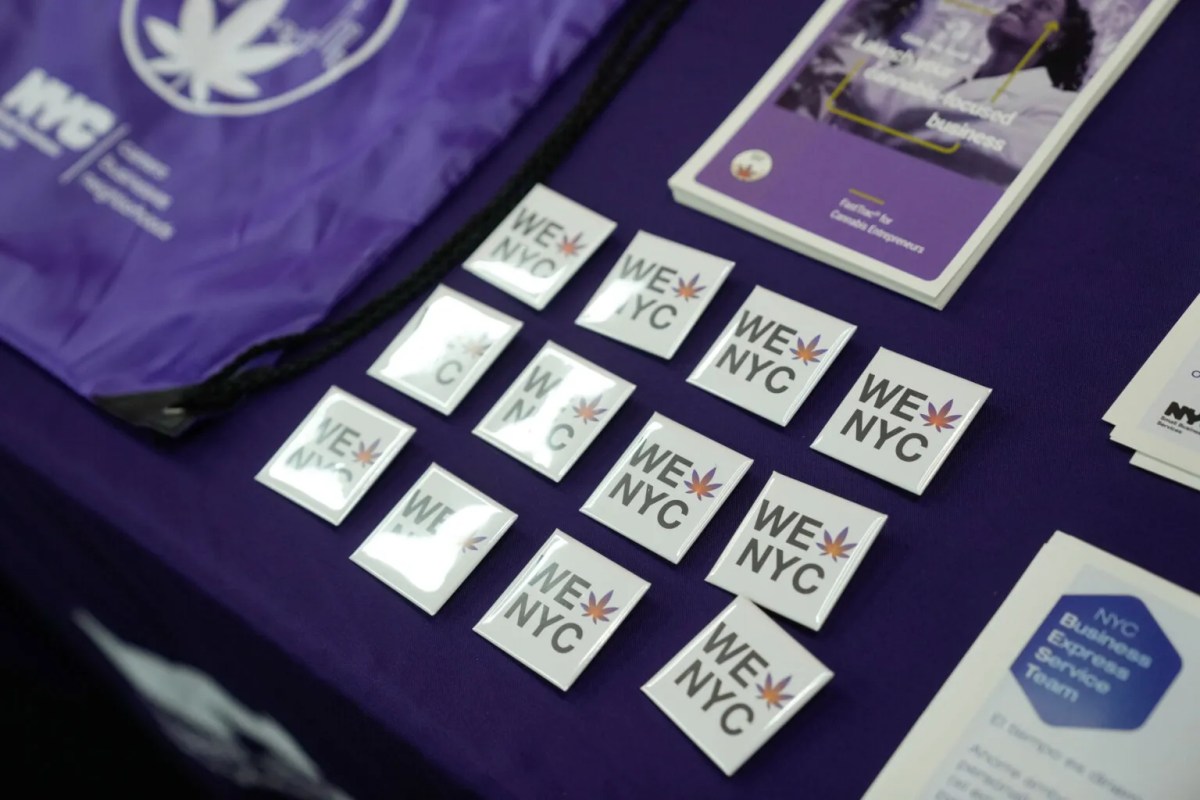
Activist Allen Roskoff spoke at a rally last August outside 186 Spring St., which was facing demolition. The city’s Landmarks Preservation Commission refused to save the building, and it was razed soon afterward.
BY ANDREW BERMAN | The Landmarks Preservation Commission has recently begun creating online slide shows to showcase various history months as represented by some of the city’s roughly 31,000 landmarked properties.
In March, L.P.C. highlighted Women’s History Month, and in February, Black History Month.
Now for the first time, L.P.C. has also created a Gay Pride Month slide show for June’s L.G.B.T. Pride and History Month. For this, L.P.C., and especially the staff who put it together, should be commended. The enlightening and useful presentation covers a broad range of landmarked sites with some connection to L.G.B.T. individuals and history. Many are, not surprisingly, located in the Village, with several others located in Staten Island, Brooklyn, Governors Island and Upper Manhattan.
Ironically, however, what the presentation lacks is a single site actually landmarked by the commission primarily because of its significance to L.G.B.T. history. And in most cases, L.P.C.’s own designation reports, which officially define a building’s significance, make no acknowledgement whatsoever of any connection to L.G.B.T. history.
In fact, L.P.C. has a rather poor record when it comes to landmarking sites whose primary significance is gay and lesbian history. In truth, the agency has never designated a single building in all of New York based primarily upon L.G.B.T. history, in spite of several requests to do so and ample opportunities in what is perhaps the premier city in the world for modern L.G.B.T. history sites.
And it may be no coincidence that L.P.C. is for the first time rolling out this L.G.B.T. History Month slide show after recently facing some pointed criticism for this failure, following its refusal to save one of the most important L.G.B.T. history sites in New York from the wrecking ball.
Last year, L.P.C. refused to even hold a public hearing on considering landmarking 186 Spring St., a largely intact 1824 rowhouse which served for more than a decade as a home of some of the most transformative figures of the post-Stonewall era in the L.G.B.T. civil rights movement.
Starting in 1969, just after the Stonewall Riots, 186 Spring St., became a “gay activist commune.” Three of the men who lived there were Jim Owles, Arnie Kantrowitz and Bruce Voeller. All three were involved with introduction of the very first gay anti-discrimination bill in the country. At the time there were absolutely no legal protections against getting fired or other forms of discrimination based upon sexual orientation, and many private- and public-sector employers — including the federal government — had explicit policies prohibiting the employment of persons found to be gay or lesbian.
Forms of this bill are now the law of the land in 21 states and the District of Columbia, as well as hundreds of counties and municipalities, including New York City and State. These three men were also among the founders of the Gay Activists Alliance, Gay and Lesbian Independent Democrats (the country’s first gay Democratic political club), and the Gay and Lesbian Alliance Against Defamation, the first national organization to advocate for fair and accurate representations of L.G.B.T. people in the media, and the National Gay and Lesbian Task Force, the first organization to advocate politically for L.G.B.T. people on a national level.
But the list of their accomplishments only begins there. Owles was the very first openly gay person to run for public office in New York. It was not until 20 years later that an openly gay person, Greenwich Village’s Deborah Glick, would win public office from New York City. Now, in addition to two city councilmembers and three other state legislators from Manhattan who are openly L.G.B.T., there are two openly gay city councilmembers from Queens, an openly gay state assemblymember from Staten Island, and an openly gay congressman from the Hudson Valley — changes probably unimaginable at that time.
Bruce Voeller, who lived at 186 Spring St. the longest, co-led the first delegation of gay rights leaders to ever meet with the White House, helped end the federal government’s ban on employing gay people, helped get homosexuality removed from the American Psychiatric Association’s list of mental illnesses, got the very first piece of federal gay rights legislation introduced, and won the first Supreme Court case establishing rights for gay parents. As Voeller turned his attention to sexual health in the 1980s, he also conducted the first study showing that condom usage could prevent the spread of H.I.V., and coined the term Acquired Immune Deficiency Syndrome, to replace the inaccurate and stigmatizing term Gay Related Immune Defense Disorder, which was at the time widely used.
This is obviously extraordinary historic significance. So extraordinary, in fact, that New York State took the extraordinary step of, the request of the Greenwich Village Society for Historic Preservation, determining the house eligible for listing on the State and National Registers of Historic Places. Had it been listed, it would have been only the third site in the entire country listed on the registers based upon significance to L.G.B.T. history (the first being the Stonewall Inn, which G.V.S.H.P. helped get listed).
But what did L.P.C. do? It refused to landmark the building, or even move ahead with the proposed South Village Historic District, of which this house was a part, which could have saved it as well if L.P.C. felt that individual landmark status was somehow unwarranted.
The commission’s rationale? A combination of specious arguments about how the house was too altered, and the people who lived there either not central enough to the L.G.B.T. rights movement or lived there for too short a time. (Voeller, by the commission’s own admission, lived there for more than a decade). But as pointed out by architectural historian Andrew Dolkart (who has written many of the L.P.C.’s own designation reports), a much different standard was applied to the landmarked Louis Armstrong House in Queens, a property that was altered far more.
So instead, just after the state issued its determination of eligibility, the city issued demolition permits. The developer, who had previously publicly stated that he intended to preserve the house, made quick work of demolishing the tiny structure in the fall of 2012. Now, it sits as a hole in the ground, as the developer is being sued by a lender who claims the developer had no right to demolish the structure, since it was being used as collateral for a loan.
Unfortunately, this is not the only time L.P.C. has refused to designate an L.G.B.T. landmark. In 2007, G.V.S.H.P. asked L.P.C. to consider landmark designation of 101 Avenue A, an incredibly architecturally distinctive 1876 tenement with a ground floor used for generations as a German immigrant social hall. But since 1979, the former hall had served as the home of the Pyramid Club, which had a profound impact on the L.G.B.T. cultural scene in the early 1980s, and was considered the birthplace of politically and socially conscious drag performance art, as well as the long-running Wigstock Festival. And it was based upon this combination of unusual factors that G.V.S.H.P. proposed it for landmark designation.
Here, too, L.P.C. refused to consider designation, though fortunately, unlike 186 Spring St,., the building was not immediately threatened. (Here, too, by the way, the state differed with the city, and declared the building eligible for the State and National Registers of Historic Places.)
Fortunately, in 2011, G.V.S.H.P. and our allies were able to get L.P.C. to expand the propsed East Village / Lower East Side Historic District to include this building and several other key sites. However, apparently L.P.C.’s willingness to do so, and its evaluation of 101 Avenue A’s significance, had nothing to do with the building’s L.G.B.T. history, since it gets no mention in the entry for the building in the commission’s designation report for the district. The report’s text is the official record of a building’s significance and what guides how it is supposed to be regulated, and protected, by L.P.C.
Which bring us to the other sites in L.P.C.’s “Gay Pride Month 2013” slideshow. Here again the work of those L.P.C. staff members behind it deserves high praise, for drawing the connections between L.G.B.T. history and individuals and many of the sites highlighted.
But in all too many cases, what is presented in the slideshow is not present in L.P.C.’s actual designation reports, and therefore has nothing to do with the history that L.P.C. has officially recognized, or committed to protect in the future. Many of the key sites from the slideshow and from New York’s L.G.B.T. history, like Stonewall Inn and the former Gay Activists Alliance Firehouse, have no mention whatsoever of their L.G.B.T. history in their designation reports.
To be fair, the Stonewall Riots did take place two months after the Greenwich Village Historic District was designated, and thus could not have been mentioned in the district’s original designation report. But L.P.C. has had nearly 45 years to correct this. In 1999 and again in 2000, the federal government recognized the Stonewall Riots’ significance by naming Stonewall and the surrounding area to the State and National Registers of Historic Places, and then naming it a National Historic Landmark. L.P.C. has neither amended its designation report to ensure that the L.G.BT. significance is recognized and protected by the commission’s future actions, nor designated Stonewall an individual landmark on this basis, which could be done as well.
That’s not to say L.P.C. has never recognized L.G.B.T. history in its designations. Webster Hall’s designation report includes reference to the drag balls and gay and lesbian gatherings that took place there, as do the designation reports of several other sites G.V.S.H.P. fought to have landmarked, such as the Gansevoort Market Historic District, the Weehawken Street Historic District and the South Village extension of the Greenwich Village Historic District.
But in all these cases, the L.G.B.T. history, while referenced, is far from the primary reason for designation. L.P.C. is yet to say that a single building or site in New York City deserves to be protected because of its connection to L.G.B.T. history, the way it has for Underground Railroad sites, the African Burial Ground, the Apollo Theater or many other sites rightfully designated for their significance to African-American history.
Thus as we celebrate L.G.B.T. Pride and History Month, we also recognize that we still have a long way to go before sites of L.G.B.T. historic significance get the protection and recognition they deserve from the New York City Landmarks Preservation Commission.
Berman is executive director, Greenwich Village Society for Historic Preservation.


















